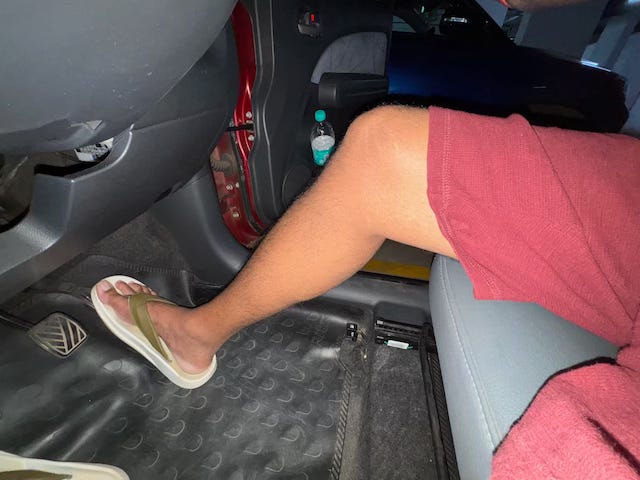My Requirements for a Car
I’m considering buying a car.
Before buying anything, I note down my requirements, rather than doing it intuitively, because in the latter case, I might forget to check an important aspect of one of the product, realising only after it’s too late. Putting anything down in writing also brings you clarity on what you really want.
As part of this process, I realised that some requirements are not really requirements, like a USB-C port — if it weren’t there, I can use the 12V port with a USB-C car charger. So I struck USB-C off the list of requirements.
When we list requirements, we tend to write a wishlist of everything we want. So I went down the list, looked at each requirement, and asked myself, “If I found an excellent car that met all the requirements except this one, would I reject it?” When the answer was no, I moved it to a Nice To Have section. Many people don’t know the difference between REQUIREments and nice to have!
I looked at the list of requirements again, and identified a car that meets all of them. It’s the Creta top-end model1. It costs 26 lakh. Then I asked my financial advisor if that’s a good amount of money to spend, and he said, “Your bank account says that you can spend 15, not 26.” So then I took another hard look at the list of requirements and removed some that I realised weren’t needed. To make good decisions, you have to look at the issue from multiple angles: one being your requirements ignoring cost, and the other being budget ignoring what benefits the car has. The human mind is not sophisticated enough to consider two factors at once. If you try, you won’t do a good job. So handle them one at a time. On one occasion, I made two lists from two different perspectives, and then reconciled them.
In addition to removing requirements, as I test drove various cars, I also added some requirements I didn’t realise earlier, like Not electric.
The list of requirements, as you can see, went through a lot of iterations. It’s a living document.
With that in mind, here are the requirements:
If it’s electric, at least 300 km range at top speed in Sport with coasting regen off and AC on2.
Comfort:
My stomach should not be pressed3.
I should be able to enter and exit the car without the steering wheel coming in the way of my knees4.
I should be able to stretch my legs in the driver and front passenger seats:
Headroom:
Notice how I’m able to spread my fingers. If I can’t, it’s too cramped.
The driver’s seat back recline angle should be electrically adjustable5.
Low vibrations: The suspension should be smooth and hide potholes, bumps and imperfections in the road. The car should float over the road. You shouldn’t feel vibrations from the road surface in the seat of the car, the floorboard or the headrest.
Low noise, whether engine noise, road noise, or the noise of wind. Some engines make a grating noise. Those cars are disqualified.
Monocoque.
Black seats6.
A great music system7.
Climate control8.
I’ve learnt everything I can from my existing car, so I need to ensure that my car doesn’t hold back my skill development as a driver:
These are the requirements, not nice-to-haves11.
Specifically, the SX(O) Turbo Petrol DCT. Technically, it’s one model below the top-end, since the only difference is the dual tone, which I don’t want.
This is not the typical balanced test consisting of city and highway driving, but the worst-case scenario for an EV.
In other words, I want a high seating position, where my legs are under me rather than in front of me. The base of the seat should be flat rather than angled upward. This rules out sedans and hot hatches.
At a minimum, the wheel shouldn’t touch my knees when I’m seated.
Otherwise, it becomes a problem — you can’t safely adjust the seat back angle while driving. Besides manual adjustment isn’t precise — it often overshoots. I ended up driving with the seat reclined too much, fighting drowsiness.
As for seat height adjustment, manual is okay, because it’s precise — each time you pump the lever, it adjusts by a set amount.
For easy maintenance.
I listen to music to not fall asleep on a long drive, and I care about the quality of music.
Otherwise, it gets too cold (exacerbating my cold) or too stuffy (making it uncomfortable to breathe).
This requires at least 98KW power output. The Windsor EV (38 KWH) delivers this much power, and it’s immensely satisfying to drive.
By contrast, the Sonet 1-liter turbopetrol DCT delivers only 88 KW and isn’t fast enough even when floored.
The KW is only a proxy, and it’s the 0-100 time that is the deciding factor for me.
Diesels don’t meet the 10s requirement: they lag, accelerate slowly, their top speed is lower, and they vibrate a lot. CNGs are supposed to share these shortcomings: they lag, they accelerate slowly, and the top speed is lower. Besides, there are only 6K fueling stations all over the country vs 100K for petrol. And you have to refill more often than petrol. In fact, there are more EV charging stations: 16K than CNG.
Even for a petrol, the 0-100 requirement means a 1.5-liter turbo.
Beyond 1.5 you get diminishing returns: I drove the Lexus NX, which has a 2.5 turbo, but it can accelerate fast without turbo lag. This is likely because the engine can generate a lot of power even before the turbo kicks in. That was good, but only a marginal improvement over the 1.5 turbo of the Creta, Seltos or Taigun. If a 2.5 turbo gets a score of 100, a 1.5 turbo gets a score of 95. And you’ll be paying more for the 2.5. So it’s not worth it.
Other transmissions like a torque converter, CVT and AMT are not as suited for spirited driving: they have lag, they can get damaged, or they jerk forward and back. Even when they’re not jerky as such, they still have noticeable discontinuities in acceleration even on luxury vehicles like the Lexus NX’s eCVT.
No matter how powerful the engine is, it doesn’t compensate for the transmission.
Here are the nice-to-haves:
CarPlay:
Does it work wired?
Is the screen sharp (HD)?
Rear seat:
Legroom
Headroom
Panoramic window
Safety:
Seat belt pretensioner with force limiter
Side airbags for the head, torso and pelvis
Electronic stability control
EBD
Active rollover protection
LED headlights
Headlights that turn on automatically in darkness / daytime running lights
Emergency brake assist
Multi-collision brake
Tyre pressure monitoring
Blind spot monitoring. You changed lanes on the expressway without noticing a vehicle in your blind spot, and was shaken up when you suddenly found a vehicle there.
Lane departure warning / lane keeping assist. On the expressway, you changed lanes at 120+ and then suddenly realised that you didn’t consciously do it.
These are proven to reduce deaths or permanent disabilities, according to ChatGPT.
Cooling:
White outside paint
Ventilated seats (perforated seats don’t let sweat evaporate).
Climate control
Turn on AC remotely, set the temperature, and see the current temperature of the car.
Cooled glove box or center console.
Rear window sunshades.
Rear AC control.




Main question: New or Pre-loved?
It looks like you are looking for New only?
If you get pre-loved you can get substantially more car for the same budget.
At the same time, you need to shop more carefully and then keep a budget for post-purchase care. This is something not everyone is ready for.